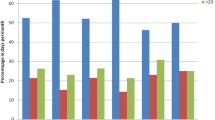Abstract
The purpose of this study was to investigate the relationship between weight status and recreational drug use in Korean adolescents. A total of 72,399 adolescent students (38,152 boys and 34,247 girls) from the middle first to high third grade participated in the 5th Korea Youth Risk Behaviour Web-based Survey (KYRBWS-V) project in 2009. They were assessed for body mass index (BMI) and recreational drug abuse. The associations between BMI and recreational drug use were examined using multivariable logistic regression analysis after adjusting for the covariate variables of age, smoking frequency and cigarette consumption, frequency of alcohol consumption and severe alcohol intoxication, amount of alcohol consumed, parents’ education level, economic status, sedentary activities during the week, mental stress, sleep duration, frequency of vigorous and moderate physical activities, and muscular strength exercises during the week. For boys, the odds ratio (OR) (95% confidence interval [CI]) between overweight and drug use were 0.990 (0.723–1.356; p = 0.950) for almost none, 0.939 (0.521–1.693; p = 0.834) for past use, and 0.791 (0.385–1.624; p = 0.523) for present use. The OR (95% CI) between obesity and drug use was 0.731(0.508–1.052; p = 0.091) for almost none, 0.755 (0.389–1.465; p = 0.407) for past use, and 0.701 (0.314–1.565; p = 0.386) for present use. For girls, the OR (95% CI) between overweight and drug use was 1.112 (0.702–1.763; p = 0.650) for almost none, 1.103 (0.464–2.619; p = 0.825) for past use, and 0.927 (0.267–3.218; p = 0.905) for present use. The OR (95% CI) between obesity and drug abuse was 0.594 (0.261–1.352; p = 0.215) for almost none, 1.318 (0.462–3.764; p = 606) for past use, and <0.001(<0.001–<0.001; p = 0.998) for present use. We concluded that recreational drug use had no correlation with overweight and obesity in Korean adolescents.
Similar content being viewed by others

References
World Health Organization. Facts and figures — Other psychoactive substances. 2011. http://www.who.int/substance_abuse/facts/psychoactives/en/index.html
Centers for Disease Control. CDC Survey Finds that 1 in 5 U.S. High School Students Have Abused Prescription Drugs. 2010. http://www.cdc.gov/media/pressrel/2010/r100603.htm
Waldron HB, Turner CW. Evidence-based psychosocial treatments for adolescent substance abuse. Journal of Clinical Child & Adolescent Psychology 2008; 37, 238–261
Boyce SH, Quigley MA. Uvulitis and partial upper airway obstruction following cannabis inhalation. Emerg. Med. (Fremantle) 2002; 14, 106–108
Taylor DR, Fergusson DM, Milne BJ, Horwood LJ, Moffitt TE, Sears MR, Poulton R. A longitudinal study of the effects of tobacco and cannabis exposure in young adults. Addiction 2002; 97, 1055–1061
Hall W, MacPhee D. Cannabis use and cancer. Addiction 2002; 97, 243–247
Earleywine M. Cannabis-induced Koro in Americans. Addiction 2001; 96, 1663–1666
Crowley TJ, Macdonald MJ, Whitmore EA, Mikulich SK. Cannabis dependence, withdrawal, and reinforcing effects among adolescents with conduct symptoms and substance use disorders. Drug Alcohol Depend 1998; 50, 27–37
Solowij N, Stephens RS, Roffman RA, Kadden T, Miller R, Christiansen M, McRee K, Vendetti B. Cognitive functioning of long-term heavy cannabis users seeking treatment. J Am Med Assoc 2002; 287, 1123–1131
Mittleman MA, Lewis RA, Maclure M, Sherwood JB, Muller JE. Triggering myocardial infarction by marijuana. Circulation 2001; 193, 2805–2809
World Health Organization: Obesity and Overweight. Global Strategy on Diet, Physical Activity and Health. 2011. http://www.who.int/mediacentre/factsheets/fs311/en/
Hyman SE, Malenka RC, Nestler EJ. Neural mechanisms of addiction: the role of reward-related learning and memory. Annu Rev Neurosci 2006; 29:565–598
Del Parigi A, Chen K, Salbe AD, Reiman EM, Tataranni PA. Are we addicted to food? Obes Res 2003; 11:493–495
Barry D, Clarke M, Petry NM. Obesity and its relationship to addictions: is overeating a form of addictive behavior? Am J Addict. 2009; 18(6), 439–451
Korea Centers for Disease Control and Prevention. The Statistics of 5th Korea Youth Risk Behavior Web-based Survey(KYRBWS) in 2009: 2010. 11. 02
Bae J, Joung H, Kim JY, Kwon KN, Kim YT, Park SW. Test-retest reliability of a questionnaire for the Korea Youth Risk Behavior Web-based Survey. J Prev Med Public Health. 2010; 43(5): 403–10
Bae J, Joung H, Kim JY, Kwon KN, Kim Y, Park SW. Validity of self-reported height, weight, and body mass index of the Korea Youth Risk Behavior Webbased Survey questionnaire. J Prev Med Public Health 2010; 43(5): 396–402
WHO/ IASO/ IOTF. The Asia-Pacific perspective: redefining obesity and its treatment. Health Communications Australia: Melbourne. 2000
Eaton DK, Kann L, Kinchen S, Shanklin S, Ross J, Hawkins J, Harris WA, Lowry R, McManus T, Chyen D, Lim C, Whittle L, Brener ND, Wechsler H. Youth Risk Behavior Surveillance-United State, 2009. Morbidity and mortality weekly report. Surveillance summaries 2010; 59:SS–5
ACSM. ACSM’s guidelines for exercise testing and prescription 8th ed. Lippincott Williams & Wilkins. 2009
Christie D, Viner R. Adolescent development. BMJ. 2005; 330(7486), 301–304
Suter PM. Is alcohol consumption a risk factor for weight gain and obesity? Crit Rev Clin Lab Sci 2005; 42:197–227
Pickering RP, Grant BF, Chou SP, Compton WM. Are overweight, obesity, and extreme obesity associated with psychopathology? Results from the national epidemiologic survey on alcohol and related conditions. J Clin Psychiatry 2007; 68:998–1009
Petry NM, Barry D, Pietrzak RH, Wagner JA. Overweight and obesity are associated with psychiatric disorders: results from the National Epidemiologic Survey on Alcohol and Related Conditions. Psychosom Med 2008; 70:288–297
Barry D, Petry NM. Associations between body mass index and substance use disorders differ by gender: results from the National Epidemiologic Survey on Alcohol and Related Conditions. Addict Behav 2009; 34(1):51–60
Author information
Authors and Affiliations
Corresponding author
About this article
Cite this article
Baek, SI., So, WY. Association between weight status and recreational drug abuse in Korean adolescents. cent.eur.j.med 7, 224–229 (2012). https://doi.org/10.2478/s11536-011-0136-8
Received:
Accepted:
Published:
Issue Date:
DOI: https://doi.org/10.2478/s11536-011-0136-8



